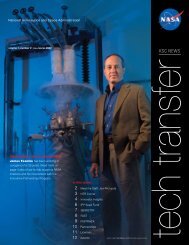2006-2007 - Kennedy Space Center Technology Transfer Office
2006-2007 - Kennedy Space Center Technology Transfer Office
2006-2007 - Kennedy Space Center Technology Transfer Office
- No tags were found...
You also want an ePaper? Increase the reach of your titles
YUMPU automatically turns print PDFs into web optimized ePapers that Google loves.
0.900.850.80Discharge Coefficient, C d0.750.700.65MLP-3 (0004) P 1= 1,590 psia0.60 MLP-3 (0009) P 1= 525 psiaMLP-3 (0015) P 1= 650 psiaMLP-3 (0014) P 1= 775 psia0.550.50 0.55 0.60 0.65 0.70 0.75 0.80 0.85 0.90Exit to Inlet Pressure Ratio, P 2/P 1Figure 2. Typical flow-versus-pressure ratio curve, as measured in air by CEESI.curve fitting of the air-flow data, in conjunction with ASME orifice modelingequations, a method of relating the helium mass flow to measured air flow datawas obtained. This analysis showed that the highest uncertainty in flow occurredin the vicinity of the choking pressure ratio, as would be expected. In addition,analysis of typical flow pulses showed that most of the helium flow occurredeither well below or well above this uncertain area. The final result is the abilityto provide postlaunch estimates of helium mass flows that are within 1.5 percentof the actual value.Contact: Stanley O. Starr , NASA-KSC, (321) 861-2262Participating Organization: United <strong>Space</strong> Alliance (Thomas J. Clark and Thomas A.Trovillion)KSC <strong>Technology</strong> Development and Application <strong>2006</strong>-<strong>2007</strong>73













